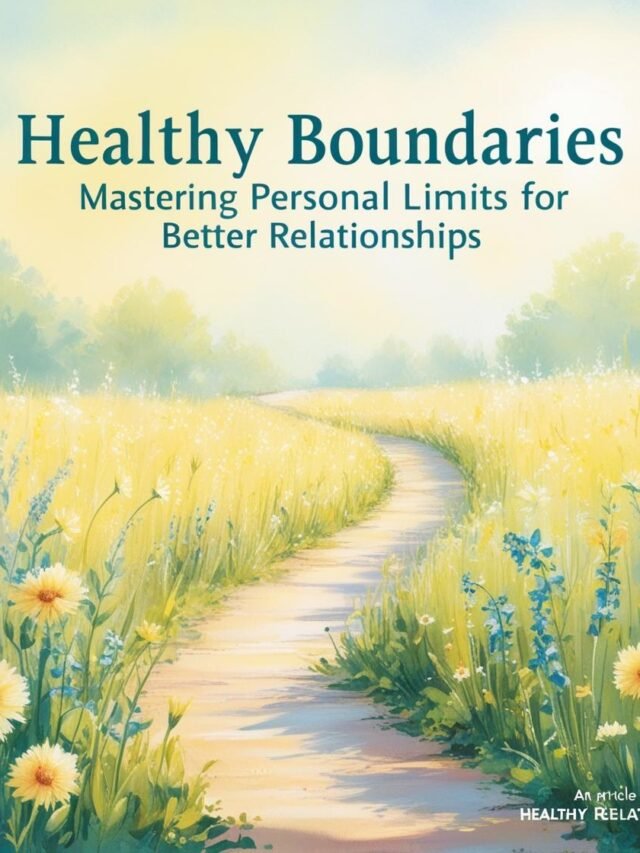Have you ever felt overwhelmed, stressed, or taken advantage of in your relationships? Do you find yourself saying “yes” when you really want to say “no”? If so, you’re not alone. Many people struggle with setting and maintaining healthy boundaries in their personal and professional lives.
Imagine a life where you feel respected, valued, and in control of your own time and energy. That’s the power of healthy boundaries! But here’s the catch: establishing boundaries isn’t always easy. It requires self-awareness, courage, and practice. Don’t worry, though – we’ve got you covered. In this blog post, we’ll dive deep into the world of healthy boundaries, exploring everything from understanding what they are to overcoming challenges in setting them.
Ready to transform your relationships and reclaim your personal power? Let’s explore the six essential aspects of healthy boundaries, starting with understanding what they truly mean and how they can positively impact your life.

Understanding Healthy Boundaries
Definition of healthy boundaries
Healthy boundaries are the limits you set in your relationships to protect your physical, emotional, and mental well-being. They define where you end and others begin, allowing you to maintain your individuality while still engaging in meaningful connections.
Importance in personal relationships
Establishing clear boundaries is crucial for maintaining healthy personal relationships. They help you:
- Communicate your needs and expectations effectively
- Respect others’ limits and personal space
- Prevent misunderstandings and conflicts
- Foster mutual trust and respect
Benefits for mental health
Setting and maintaining healthy boundaries can significantly improve your mental health by:
- Reducing stress and anxiety
- Boosting self-esteem and confidence
- Enhancing your sense of identity and self-worth
- Promoting emotional stability and resilience
Types of boundaries
There are various types of boundaries you can establish in your life:
| Boundary Type | Description | Example |
|---|---|---|
| Physical | Limits on your personal space and body | Deciding who can touch you and how |
| Emotional | Separating your feelings from others’ | Not taking responsibility for others’ emotions |
| Time | Managing your schedule and commitments | Learning to say no to additional tasks |
| Intellectual | Respecting your thoughts and beliefs | Agreeing to disagree on certain topics |
| Material | Setting limits on your possessions | Deciding when and how to lend your belongings |
Understanding these different types of boundaries allows you to identify areas in your life where you may need to establish or strengthen limits. By doing so, you’ll be better equipped to navigate your relationships and maintain your overall well-being.

Recognizing Boundary Issues
Now that we understand what healthy boundaries are, let’s explore how to recognize boundary issues. Identifying these problems is crucial for maintaining healthy relationships and personal well-being.
Signs of weak boundaries
Weak boundaries can manifest in various ways. Here are some common signs to watch out for:
- Difficulty saying “no” to others’ requests
- Feeling responsible for others’ emotions
- Oversharing personal information
- Neglecting your own needs to please others
- Accepting disrespectful behavior from others
Consequences of poor boundaries
When you don’t establish or maintain healthy boundaries, you may experience:
| Consequence | Description |
|---|---|
| Burnout | Exhaustion from constantly putting others’ needs first |
| Resentment | Feeling angry or bitter towards others for taking advantage |
| Loss of identity | Losing sight of your own values and desires |
| Unhealthy relationships | Attracting or tolerating toxic connections |
Common boundary violations
Recognizing boundary violations is essential for protecting your well-being. Some frequent violations include:
- Unwanted physical contact
- Invading personal space
- Sharing your private information without consent
- Making decisions for you without your input
- Criticizing your choices or beliefs
By identifying these issues, you can take the first step towards establishing healthier boundaries in your life. Next, we’ll explore effective strategies for setting and communicating these boundaries.

Setting Effective Boundaries
Now that you understand the importance of boundaries and can recognize boundary issues, it’s time to learn how to set effective boundaries in your life. This crucial skill will help you maintain healthier relationships and improve your overall well-being.
Identifying Your Personal Limits
To set effective boundaries, you must first identify your personal limits. Take some time to reflect on:
- Your values and beliefs
- Your emotional and physical needs
- Situations that make you uncomfortable
- Behaviors you find unacceptable
| Areas to Consider | Examples of Personal Limits |
|---|---|
| Time and Energy | Not working overtime regularly |
| Personal Space | Needing alone time daily |
| Emotional Needs | Not tolerating verbal abuse |
| Physical Boundaries | Respecting personal space |
Communicating Boundaries Clearly
Once you’ve identified your limits, it’s essential to communicate them clearly to others. Remember:
- Use “I” statements to express your needs
- Be specific about what you’re comfortable with
- Avoid apologizing for having boundaries
- Be firm but respectful in your tone
Enforcing Boundaries Consistently
Setting boundaries is only half the battle; you must also enforce them consistently. This means:
- Following through on consequences when boundaries are crossed
- Avoiding making exceptions that undermine your boundaries
- Regularly reassessing and adjusting your boundaries as needed
Dealing with Pushback
When you start setting boundaries, you may encounter resistance. To handle pushback effectively:
- Stay calm and composed
- Reaffirm your boundary without justifying it
- Recognize that others’ reactions are not your responsibility
- Seek support from trusted friends or professionals if needed
By mastering these aspects of setting effective boundaries, you’ll be well on your way to creating healthier relationships and a more balanced life. Next, we’ll explore how boundaries function in different types of relationships.

Boundaries in Different Relationships
Now that we’ve explored how to set effective boundaries, let’s dive into how these boundaries apply to various types of relationships in your life.
A. Family boundaries
Family relationships can be complex, and setting boundaries is crucial for maintaining healthy interactions. You might need to establish limits on topics of conversation, frequency of visits, or expectations of support. For example:
- Respectful communication during disagreements
- Personal space and privacy within the household
- Financial independence and responsibilities
B. Romantic relationship boundaries
In romantic partnerships, clear boundaries help foster trust and mutual respect. Consider setting boundaries around:
- Emotional and physical intimacy
- Personal time and space
- Shared responsibilities and decision-making
C. Workplace boundaries
Professional relationships benefit from well-defined boundaries that promote a productive and respectful work environment. Focus on:
- Work-life balance (e.g., after-hours communication)
- Professional conduct and appropriate interactions
- Clear job responsibilities and expectations
D. Friendships and social boundaries
Healthy friendships thrive on mutual respect and understanding. Establish boundaries that address:
- Time and energy commitments
- Emotional support and reciprocity
- Personal information sharing
E. Digital and social media boundaries
In our interconnected world, digital boundaries are increasingly important. Consider setting limits on:
- Social media usage and online interactions
- Sharing personal information online
- Digital communication expectations (e.g., response times)
| Relationship Type | Key Boundary Areas |
|---|---|
| Family | Communication, privacy, support |
| Romantic | Intimacy, personal space, shared responsibilities |
| Workplace | Work-life balance, professional conduct |
| Friendships | Time commitments, emotional support |
| Digital | Online sharing, communication expectations |
By tailoring your boundaries to each type of relationship, you can create healthier, more fulfilling connections across all areas of your life. Next, we’ll explore common challenges you might face when setting boundaries and strategies to overcome them.

Overcoming Challenges in Boundary Setting
Setting boundaries can be difficult, but you’re not alone in facing these challenges. Let’s explore some common obstacles and how you can overcome them.
Dealing with guilt
You might feel guilty when setting boundaries, especially with loved ones. Remember that healthy boundaries benefit both you and others. To overcome guilt:
- Remind yourself that self-care is not selfish
- Practice positive self-talk
- Acknowledge your right to have boundaries
Managing fear of conflict
Fear of conflict can make you hesitant to establish boundaries. Here’s how you can address this:
- Start small and build confidence
- Use “I” statements to express your needs
- Practice assertive communication
- Visualize positive outcomes
Addressing people-pleasing tendencies
If you’re a people-pleaser, setting boundaries might feel uncomfortable. Try these strategies:
- Prioritize your own needs
- Learn to say “no” without explanation
- Recognize that you’re not responsible for others’ happiness
Navigating cultural expectations
Cultural norms can sometimes conflict with personal boundaries. Here’s how you can manage this:
| Strategy | Description |
|---|---|
| Educate | Explain your boundaries and their importance |
| Compromise | Find middle ground when possible |
| Stand firm | Politely maintain boundaries when necessary |
Remember, setting boundaries is a skill that improves with practice. As you work through these challenges, you’ll become more confident in establishing and maintaining healthy boundaries in various aspects of your life.

Maintaining and Adjusting Boundaries
Now that you’ve established healthy boundaries, it’s crucial to understand that they’re not set in stone. Life is dynamic, and your boundaries should be too. Let’s explore how you can maintain and adjust your boundaries effectively.
Regular self-assessment
You should regularly check in with yourself to evaluate your boundaries. Ask yourself:
- Are your current boundaries serving you well?
- Do you feel respected and comfortable in your relationships?
- Are there areas where you feel overwhelmed or stressed?
Use this self-assessment checklist to guide your reflection:
| Aspect | Yes | No | Needs Improvement |
|---|---|---|---|
| Personal space | |||
| Time management | |||
| Emotional well-being | |||
| Work-life balance |
Adapting boundaries as life changes
Your life circumstances will inevitably change, and your boundaries should evolve accordingly. Be prepared to:
- Reassess your priorities
- Communicate changes to others
- Be flexible but firm in your new boundaries
Seeking support when needed
Remember, you don’t have to navigate boundary maintenance alone. Consider:
- Discussing challenges with trusted friends or family
- Seeking professional help from a therapist or counselor
- Joining support groups for boundary setting
By regularly assessing, adapting, and seeking support, you’ll ensure your boundaries remain healthy and effective as you grow and change. Next, we’ll recap the key takeaways from this guide to help you on your journey to maintaining healthy boundaries.
Establishing and maintaining healthy boundaries is crucial for your overall well-being and personal growth. By understanding what boundaries are, recognizing issues, and learning how to set effective limits in various relationships, you can create a more balanced and fulfilling life. Remember that setting boundaries is an ongoing process that requires practice and self-reflection.
As you navigate the challenges of boundary setting, be patient with yourself and others. Continuously assess and adjust your boundaries as needed to ensure they align with your values and needs. By prioritizing your mental health and fostering respectful relationships, you’ll cultivate a more positive and empowering environment for yourself and those around you.








